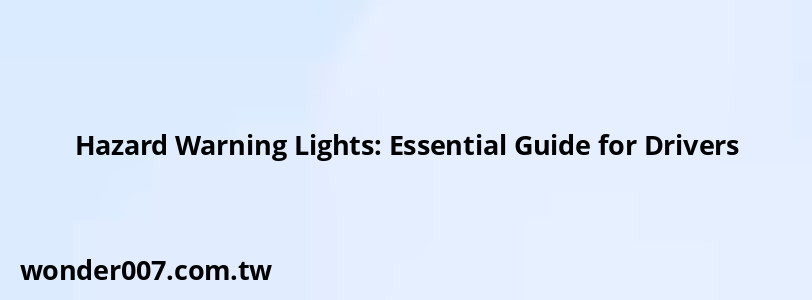Hazard Warning Lights: Essential Guide for Drivers

Hazard warning lights are a crucial safety feature in vehicles, designed to alert other road users of potential dangers. Understanding when to use these lights is essential for safe and responsible driving.
When to Use Hazard Warning Lights
Hazard warning lights should be used in specific situations to ensure road safety:
- Vehicle breakdown: Activate hazard lights if your car breaks down on the road or shoulder.
- Accident: Turn on hazards immediately after a collision to warn approaching vehicles.
- Emergency stopping: Use when you need to stop suddenly due to an obstruction or hazard ahead.
- Changing a tire: Activate hazards when you're forced to stop and change a tire on the roadside.
- Towing: When being towed, use hazard lights to increase visibility.
Motorway and Dual Carriageway Use
On motorways and unrestricted dual carriageways, hazard lights can be used briefly to warn drivers behind you of a hazard or sudden traffic slowdown ahead. However, only use them for a short duration to ensure your warning is noticed.
When Not to Use Hazard Warning Lights
Misusing hazard lights can lead to confusion and potentially dangerous situations. Avoid using them in these circumstances:
- Regular driving: Never use hazards while driving normally, even in bad weather.
- Illegal parking: Don't use them as an excuse for dangerous or illegal parking.
- Turning or exiting: Hazards override your indicators, making it impossible to signal turns.
- Slow driving: If you're driving slowly, use your regular lights instead.
Legal Considerations
In many countries, using hazard lights inappropriately can result in fines or penalty points on your license. Always follow local traffic laws regarding the use of hazard warning lights.
Proper Use of Hazard Lights
To effectively use hazard warning lights:
1. Locate the hazard light button (usually a red triangle) on your dashboard.
2. Press the button to activate all four indicators simultaneously.
3. Ensure your vehicle is visible to other road users before activating.
4. Turn off hazard lights once the danger has passed or your vehicle is no longer an obstruction.
Remember, hazard lights are meant for temporary use in genuine emergency situations. Using them correctly helps maintain road safety for all users.
FAQs About Hazard Warning Lights
- Can I drive with hazard lights on?
Generally, no. Hazard lights should only be used when stationary or in specific emergency situations on motorways. - Are hazard lights required by law?
In most countries, vehicles manufactured after a certain date are required to have hazard warning lights installed. - Do hazard lights drain the battery?
Extended use can drain the battery, especially if the engine is off. Use them sparingly when the vehicle isn't running.
Related Posts
-
2006 Toyota Sienna: Essential Cabin Air Filter Guide
28-01-2025 • 190 views -
High Mount Brake Light Not Working: Troubleshooting Guide
30-01-2025 • 187 views -
2003 Toyota Camry Tail Light Bulb Replacement Guide
27-01-2025 • 188 views -
Kia Optima Check BSD System: Troubleshooting Guide
26-01-2025 • 222 views -
Ford Expedition Dashboard Warning Lights Guide
26-01-2025 • 210 views
Latest Posts
-
2015 Chevy Traverse AC Recharge Port Location
01-02-2025 • 409 views -
How To Turn Off Paddle Shifters Mercedes
01-02-2025 • 377 views -
Power Steering Fluid Leak On Passenger Side
01-02-2025 • 457 views -
Are O2 Sensors Covered Under Warranty
01-02-2025 • 376 views -
Rear Brake Caliper Piston Won't Compress
01-02-2025 • 356 views
Popular Posts
-
V12 Engine Costs: What You Need to Know
26-01-2025 • 679 views -
EPC Light: Understanding Causes and Solutions
26-01-2025 • 1053 views -
EPC Warning Light: What It Means for Your Vehicle
27-01-2025 • 630 views -
Hino Warning Lights: Understanding Dashboard Alerts
26-01-2025 • 765 views -
Power Steering and ABS Light On: Causes and Solutions
27-01-2025 • 643 views
